As the site is updated, each listing includes the shipping cost. Some listings which I have not updated still give you calculated shipping costs based on weight and size of package. (In the sections I have updated) If you select several different listings, we will consolidate your order and charge you the actual cost of the entire package. The shipping over charge will be refunded to you, when your order is shipped.
MUREX SHELLS
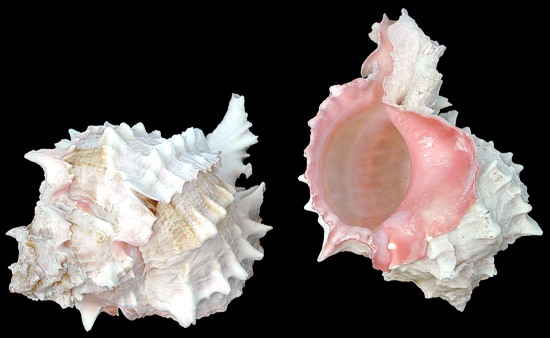
Hexaplex Erythrostomus common name Pink Throat Murex
Pink Throat Murex are a species of sea snail, a marine gastropod mollusk in the family Muricidae, the murex snails or rock snails.
this species is globose and strong, ornamented with blunt spines. The aperture is circular. The siphonal canal is narrow, short and curved with decorations on the outside. The color of the outer part of the shell is white or shades of gray. The interior of the shell and the aperture is deep pink and glossy.
(REF: Hexaplex erythrostomus (Swainson, 1831). Retrieved through: World Register of Marine Species) (REF: González V. Luz María. 2005: Guía ilustrada de los gastropodos marinos de la Bahía de Tenacatati, Jalisco, Mexico. Scientia Cucba. )
The species occurs on the west coast of Mexico from Baja California to Peru
(REF: González V. Luz María. 2005: Guía ilustrada de los gastropodos marinos de la Bahía de Tenacatati, Jalisco, Mexico. Scientia Cucba)(REF: Baqueiro Cardenas, Erick. y Aldana Aranda, Dalila. 2003:Patrones en la biología poblacional de moluscos de importancia comercial en México. Rev. Biol. Trop., 51, Supl. 4:(REF: Baqueiro Cardenas, Erick, Massó R. José A. y Vélez V, Alfonzo. Crecimiento y reproducción de una población de caracol chino Hexaplex erythrostomus (Swainson, 1831), de Bahía Concepción, B.C.S) (REF: Reyes Mejia, Alejandra. 2004: Base ee Datos de la Colección Biológica de la Secretaría de Marina Armada de México (Moluscos: Gasteropodos Y Bivalvos). Universidad Autónoma Metropolitana Unidad Iztapalapa)
The Pink Throat Murex inhabits the intertidal and subtidal zones in sandy areas and sometimes on rocks
The Pink Throat Murex on average grows between 3 to 6 inches. The shell surface has a number of spiny vertical folds, ridges and a very fine encircling lines. The aperture is large and round; outer lip thickened at its edge and armed with hollow folded spines. As the shell grows another varix is added. There is a columellar callus reflected over the body whorl. The canal is broad, closed and bends backwards
(REF: González V. Luz María. 2005: Guía ilustrada de los gastropodos marinos de la Bahía de Tenacatati, Jalisco, Mexico. Scientia Cucba)
Scientific classification
Domain: Eukaryota
Kingdom: Animalia
Phylum: Mollusca
Class: Gastropoda
Subclass: Caenogastropoda
Order: Neogastropoda
Family: Muricidae
Genus: Hexaplex
Species: H. Erythrostomus
Binomial name: Hexaplex Erythrostomus
(Swainson, 1831)
G1-6
One Pink Throat Murex Shell, measuring 2 to 3 inches (note that these are immature shells and many may not have a deep pink coloration)....... .65
G3-6
One Pink Murex Shell, measuring 3 to 4 inches.......$1.15
G4-6
One Pink Murex Shell, measuring 4 to 4.5 inches.......$1.49
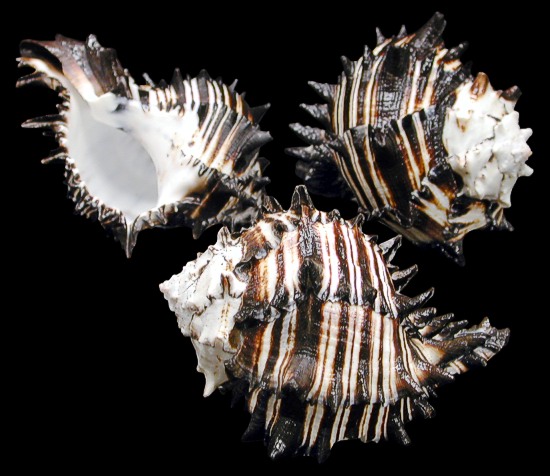
Muricanthus radix common name Radix Murex or Black Murex
The Radix, Black or Root Murex, are a species of sea snail, a marine gastropod mollusk in the family Muricidae, the murex snails or rock snails.
(REF: MolluscaBase eds. (2021). MolluscaBase. Muricanthus radix (Gmelin, 1791). Accessed through: World Register of Marine Species )
These species dwell in the western Pacific, in parts of Central America (Baja California, from Mexico to Peru)
(REF: "Hexaplex (Muricanthus) radix". Gastropods.com. )(REF: Galli C.: WMSDB - Worldwide Mollusc Species Data Base)
The Black Murex species can be found in the western Pacific in parts of Central America (Baja California, from Mexico to Peru)
(REF: "Hexaplex (Muricanthus) radix". Gastropods.com) (REF: Galli C.: WMSDB - Worldwide Mollusc Species Data Base)
These species dwell along the tropical coasts in shallow waters among intertidal rocks
Shells of Muricanthus Radix commonly grow 2 to 6 inches. These large, massive, heavy shells are globose or pear-shaped and very spiny, with a white surface and blackish-brown foliations and spiral elements. The body whorls have six to eleven varices. The aperture is large, broad, ovate and porcelaneous white. The outer edges are strongly dentate. The siphonal canal is moderately long. The operculum is dark brown.
These species are similar to Hexaplex Nigritus. The shells of these two species mainly differ in the length, width and in the proportion of blackish-brown versus white. The shells of Hexaplex Radix are less oblong and show fewer spines in black.[4][5]
(REF: George E. Radwin; Anthony D'Attilio (1976). Murex Shells of the World: An Illustrated Guide to the Muricidae. Stanford University Press)
Hexaplex Radix are carnivorous feeding primarily on clams
Scientific classification
Domain: Eukaryota
Kingdom: Animalia
Phylum: Mollusca
Class: Gastropoda
Subclass: Caenogastropoda
Order: Neogastropoda
Family: Muricidae
Subfamily: Muricinae
Genus: Muricanthus
Species: M. radix
Binomial name: Muricanthus radix
(Gmelin, 1791)
I6-17
One Black Murex Shell, measuring 3.5 to 4 inches. .... $2.10
I7-17
One Black Murex Shell, measuring 4 to 5 inches. ..... $2.45
I8-17
A Black Murex Shell that measures at least 5 inches....... $3.50
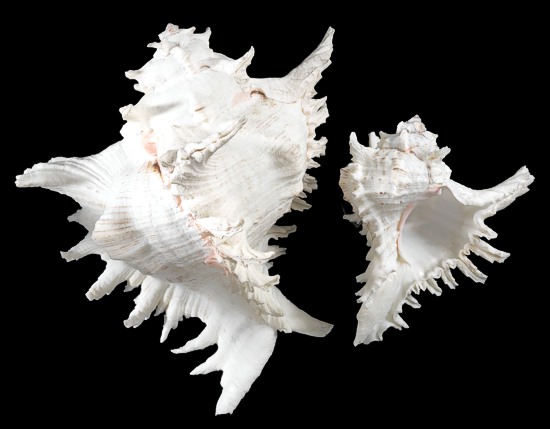
Chicoreus Ramosus, common name Ramose Murex
Ramose Murex are predatory sea snails, a marine gastropod mollusk in the family Muricidae, the murex snails. It is considered an economically important species in the Indo-West Pacific, especially in India.
(REF:Poutiers, J. M. (1998). "Gastropods". In Carpenter, K. E.; Niem, V. H. (eds.). The living marine resources of the Western Central Pacific Volume 1. Seaweeds, corals, bivalves and gastropods)
These sea snails are found widely spread in the Indo-West Pacific, and from east to South Africa, including Mozambique, Tanzania, Madagascar, the Red Sea, the Gulf of Oman, Aldabra, Chagos and Mauritius. They also dwell in eastern Polynesia, southern Japan, New Caledonia and Queensland in Australia.
(REF:) Poutiers, J. M. (1998). "Gastropods". In Carpenter, K. E.; Niem, V. H. (eds.). The living marine resources of the Western Central Pacific Volume 1. Seaweeds, corals, bivalves and gastropods) (REF: Chicoreus ramosus (Linnaeus, 1758). Retrieved through: World Register of Marine Species)
Chicoreus Ramosus have a large, solid, very rugged and heavy shell, that can grow up to 13 inches in length. It has a relatively globose outline, possessing a short spire, a slightly inflated body whorl, and a moderately long siphonal canal. One of its most striking ornamentations are the conspicuous, leaf-like, recurved hollow digitations. It also presents three spinose axial varices per whorl, with two elongated nodes between them. The shell is colored white to light brown externally, with a white aperture, generally pink towards the inner edge, the outer lip and the columella.
(REF:) Poutiers, J. M. (1998). "Gastropods". In Carpenter, K. E.; Niem, V. H. (eds.). The living marine resources of the Western Central Pacific Volume 1. Seaweeds, corals, bivalves and gastropods) (REF: Chicoreus ramosus (Linnaeus, 1758). Retrieved through: World Register of Marine Species)
The Ramose murex inhabits sandy and rubble bottoms near coral reefs, to depths of around 33 feet
The Chicoreus Ramosus are carnivorous primarily preying on bivalves and other gastropods.
(REF: Poutiers, J. M. (1998). "Gastropods". In Carpenter, K. E.; Niem, V. H. (eds.). The living marine resources of the Western Central Pacific Volume 1. Seaweeds, corals, bivalves and gastropods)
Scientific classification
Domain: Eukaryota
Kingdom: Animalia
Phylum: Mollusca
Class: Gastropoda
Subclass: Caenogastropoda
Order: Neogastropoda
Family: Muricidae
Genus: Chicoreus
Species: C. ramosus
Binomial name: Chicoreus Ramosus
(Linnaeus, 1758)
C0-3
One Pacific Ramosus Murex measuring 3 to 4 inches. ...... $2.80
C1-3
A Pacific Ramosus Murex shell, measuring 4 to 5 inches. ......$3.75
C2-3
A Pacific Ramosus Murex shell, measuring 5 to 6 inches. ......OUT OF STOCK
C3-3
A Pacific Ramosus Murex shell, measuring 6 to 7 inches. ......$5.95
C4-3
One Pacific Ramosus Murex shell measuring 7 to 8 inches ...… $6.89
C5-3
A single Pacific Ramosus Murex shell, measuring 8 to 9 inches. .....$10.65
C6-3
One Pacific Ramosus Murex shell 9 to 10 inches.....$17.50
C7-3
One Pacific Ramosus Murex shell measuring at least 10 inches ...…$27.50
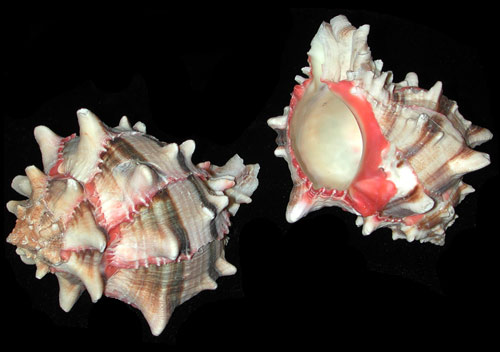
Hexaplex Brassicacommon name Brassica Murex
Hexaplex brassica are sea snails, a marine gastropod mollusk in the family Muricidae, the murex snails or rock snails.
This species is found offshore in depths to 55 m from Guaymas, in Mexico, south to Peru, and is more commonly indigenous to Costa Rica.
These mollusks prefer moderately shallow water and some species have been found up to 8 inches in size. The shell body has about 8 whorls, each with several rather flattish varices, serrated at the edges and developing into frondlike spines at the shoulders. The Brassica is whitish with a yellow tint, some pinkish shells have been found. Most Brassica Murex have 3 brown bands. The aperture is pinkish.
(REF: Hexaplex Brassica (Lamarck, 1822)
Scientific classification
Domain: Eukaryota
Kingdom: Animalia
Phylum: Mollusca
Class: Gastropoda
Subclass: Caenogastropoda
Order: Neogastropoda
Family: Muricidae
Genus: Hexaplex
Species: H. brassica
Binomial name: Hexaplex Brassica
(Lamarck, 1822)
U1-8
A single Murex Brassica shell, measuring 2 to 3.5 inches.......$4.25
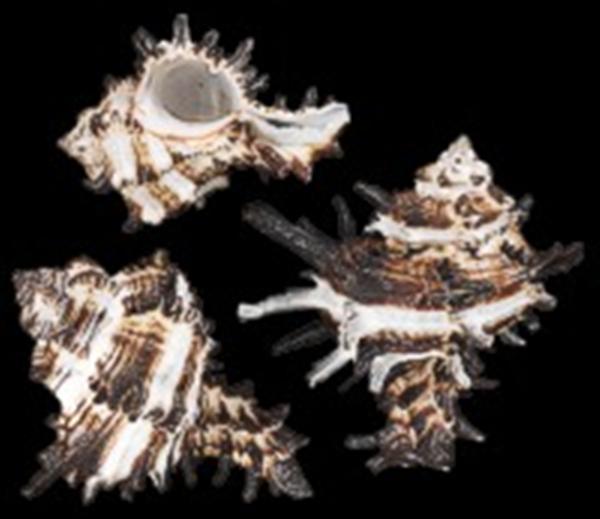
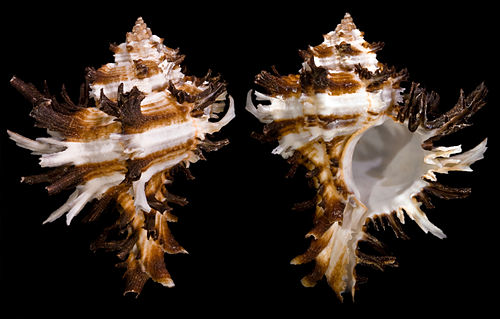
Hexaplex Cichoreum, common name Endive Murex
The Endive Murex are medium-sized species of sea snails, a marine gastropod mollusk in the family Muricidae, the murex shells or rock snails
The Endive Murex is oblong, fusiform shell that varies between 2 to 6 inches. These shells ave a short spire consisting of eight to nine ventricose whorls that become flat-shouldered and thick with age. They are transversely ridged and striated. The shell shows six to seven frondose varices, with the fronds elevated and recurved. The umbilicus is rather large and deep. Its color is yellowish-brown, frequently banded with a darker tint. The fronds are usually dark brown or blackish. The white, almost round aperture has a rather long, open posterior siphonal canal that gradually widens, but is narrow and turns to the right at the beginning. lips are tinged with pink. There is also an all-white variety (var. albicans) from the Philippines.
(REF:Houart, R. (2013). Hexaplex cichoreum (Gmelin, 1791). Accessed through: World Register of Marine Species ) (REF: G.W. Tryon (1880) Manual of Conchology II, Academy of Natural Sciences, Philadelphia) (REF: Histoire naturelle des animaux sans vertèbres... Par Jean Baptiste Pierre Antoine de Monet de Lamarc
The Endive Murex, sea snail distribution is restricted to the West Pacific. Regions where it is found include Indonesia, Papua New Guinea and the Philippines
(REF: Poutiers, J. M. (1998). "Gastropods". In Carpenter, K. E.; Niem, V. H. (eds.). The living marine resources of the Western Central Pacific Volume 1)
Scientific classification
Domain: Eukaryota
Kingdom: Animalia
Phylum: Mollusca
Class: Gastropoda
Subclass: Caenogastropoda
Order: Neogastropoda
Family: Muricidae
Genus: Hexaplex
Species: H. cichoreum
Binomial name: Hexaplex Cichoreum
(Gmelin, 1791)
A1-9
One quarter pound of Murex Indivia shells measuring 1 1/2 to 3 inches. ...... $1.19
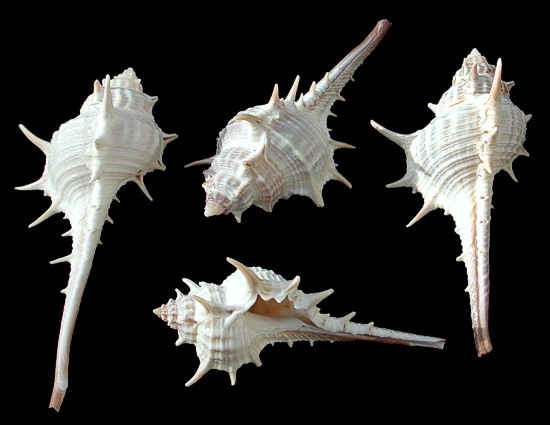
Murex ternispina also known as Murex Nigrospinosus
Murex Turnispina is a species of sea snail, a marine gastropod mollusk in the family Muricidae, the murex snails or rock snails
This species ranges across the Indo-Pacific, from the Indian Ocean east to the northern shores of Australia/New Zealand in shallow water.
The Murex Turnispina is a spine covered shell. It is club shaped with an acutely pointed apex with rounded whorls. The suture is deeply impressed and it has a long, straight siphonal canal. The color is grayish white.
(REF: Murex Ternispina Lamarck, 1822)
Scientific classification
Domain: Eukaryota
Kingdom: Animalia
Phylum: Mollusca
Class: Gastropoda
Subclass: Caenogastropoda
Order: Neogastropoda
Family: Muricidae
Genus: Murex
Species: M. ternispina
Binomial name: Murex ternispina
Lamarck, 1822
D1-8
One Turnispina Murex shell, measuring 1 to 2 inches. ...... .12
D2-8
A Murex Turnispina shell, measuring 2 to 3 inches....... .14
D3-8
One Turnispina Murex shell, measuring 3 to 4 inches....... .16
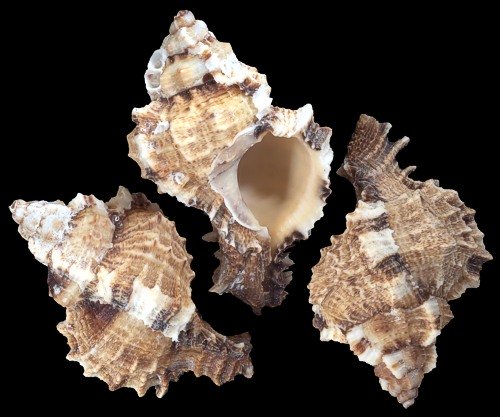
Phyllonotus Pomumcommon name Apple Murex
The apple murex, is a species of the sea snail, a marine gastropod mollusk in the family Muricidae, the murex snails or rock snails.
The adult Apple Murex shell commonly grows between 2 to 5 1/2 inches.
(REF:Lovell Augustus Reeve (1845). Conchologia Iconica: Or, Illustrations of the Shells of Molluscous Animals: )
The Apple Mures shell is rather oblong, thick, solid, very rough throughout, transversely ridged, tuberculated between the varices ; three-varicose, varices tuberculated with a complicated mass of laminae ; fulvous or reddish brown, columella and interior of the aperture ochraceous yellow, columellar lip slightly wrinkled, edge erected, vividly stained, especially at the upper part, with very black brown ; outer lip strongly toothed, ornamented with three black-brown spots ; canal rather short, compressed, recurved.
(REF: Lovell Augustus Reeve (1845). Conchologia Iconica: Or, Illustrations of the Shells of Molluscous Animals)
This species dwells in the Caribbean Sea, the Gulf of Mexico and the Lesser Antilles; in the Atlantic Ocean between North Carolina and Northern Brazil.
Scientific classification
Kingdom: Animalia
Phylum: Mollusca
Class: Gastropoda
(unranked): clade Caenogastropoda
clade Hypsogastropoda
clade Neogastropoda
Super family: Muricoidea
Family: Muricidae
Subfamily: Muricinae
Genus: Phyllonotus
Species: P. pomum
Binomial name: Phyllonotus pomum(Gmelin, 1791)
Apple Murex
The Apple Murex shell is robust, with a short spire and a rounded body whorl. Each whorl features three thick, unevenly spaced varices, separated by one or two short vertical ribs. The aperture is large and circular, while the outer lip displays a serrated edge. The shell's color ranges from yellow to dark brown, typically adorned with white or brown blotches and streaks. The aperture may appear white, orange, or yellow. As a carnivorous species, the Apple Murex prefers to bore holes into oyster shells to consume the mollusk within. It inhabits the rocky, sandy coastal areas of the Southeastern United States, particularly along Florida's West coast and the Caribbean. It belongs to the Muricidae family and is scientifically named Phylonotus Pomum.
E1-9
An Apple Murex shell, measuring 2 to 2.5 inches....... .24
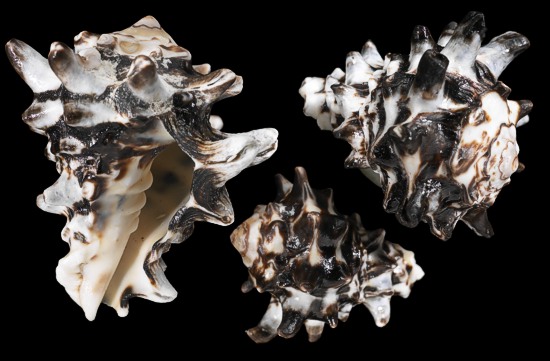
Vasum ceramicum common name Ceramic Vase or Heavy Whelk
The Vasum Ceramicum is a species of medium to large sea snail, a marine gastropod mollusk in the family Turbinellidae
(REF: Vasum ceramicum (Linnaeus, 1758))
The Vasum Ceramicum has a large, thick and heavy shell that on average reaches a length of 2 1/3 to 6 1/5 inches. This shell is quite elongated, conical or vase-shaped (hence the common name). It has long siphonal canal, three strong, columella folds and 7-10 strong spiny tubercles in each loop. It is colored white and greys or dark brown externally, while the aperture may be colored white or pale brown.
The Vasum Murex are widespread in the Mascarene Plateau, off the coast of Madagascar, and Tanzania.
This sea snail lives on lower eulittoral (the intertidal zone), rocky areas at depths of 33 to 132 feet.
(REF: Vasum ceramicum (Linnaeus, 1758))
Scientific classification
Domain: Eukaryota
Kingdom: Animalia
Phylum: Mollusca
Class: Gastropoda
Subclass: Caenogastropoda
Order: Neogastropoda
Family: Turbinellidae
Subfamily: Vasinae
Genus: Vasum
Species: V. ceramicum
Binomial name: Vasum ceramicum
(Linnaeus, 1758)
H1-9
One quarter pound of Vasum Murex shells, measuring 1.5 to 2 inches....... $1.10
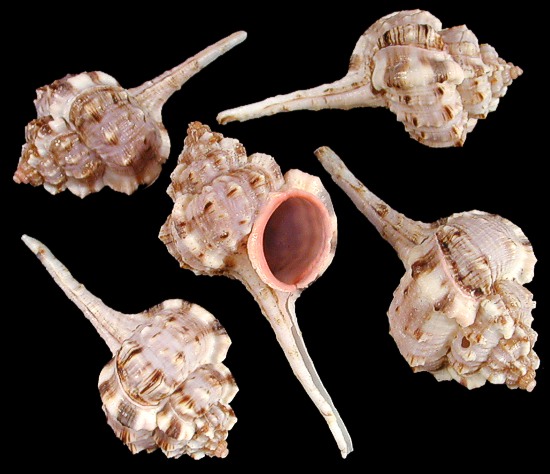
Murex Haustellum
The Haustellum Murex shell is robust and low-spired with a lengthy, straight siphonal canal. Vertical ridges appear on the later-developed body whorls, which are complete turns around the shell's imaginary axis. Its smooth varices, the thickened former lip edges of a gastropod shell, are intersected by strong spiral riblets. The siphonal canal features minimal spines. The shell's hue ranges from creamy to pinkish, adorned with brown spots and dashes, while the varices boast a rusty red. The aperture lips may be orange or pink. Commonly found in the Indo-Pacific region, this shell's habitat extends from the Indian Ocean eastward to the northern shores of Australia and New Zealand, reaching northward to just south of the Sea of Japan, favoring intertidal sand flats.
MH1-10
One Haustellum Murex shell, measuring 2 to 3 inches...... .17
MH2-10
A Haustellum Murex shell, measuring 3 to 4 inches....... $1.40
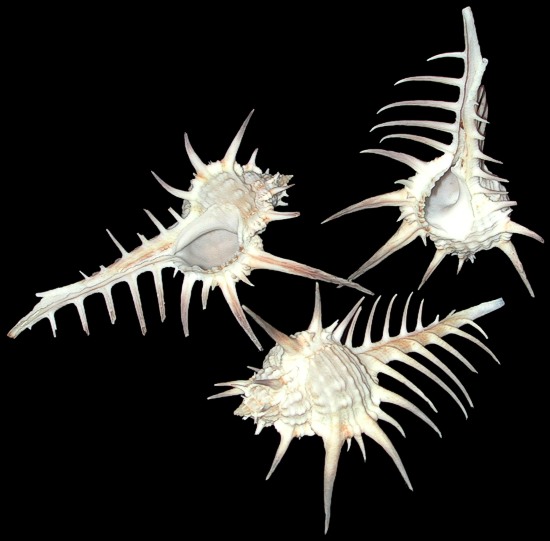
Murex Negros
The Black-spined Murex, scientifically known as Nigrispinosus, belongs to the genus Murex within the gastropod class—a mollusk group characterized by a single shell. This species is part of the Muricidae family and is indigenous to the Indo-Pacific region, which extends from the Indian Ocean to Australia's northern coasts. Typically found at depths of 44 feet, its name is derived from a Philippine island. Like its Murex counterparts, the Black-spined Murex is carnivorous, thriving in the tropical waters near coral reefs, and is noted for its ornate long spines and siphonal canal.
GGG3-17
One Murex Negros shell, measuring 2 to 3 inches, priced at $1.29.
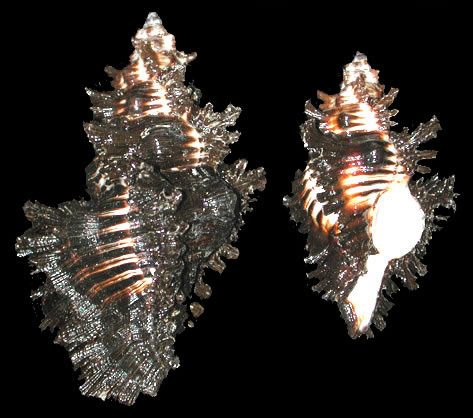
Lace Murex Shell
The Lace Murex, scientifically named Chioreus Florifer Dilectus, is a member of the Murex family and is sometimes referred to as the Florida Lace Murex. It features an elongated ovate shape with a high, conical spire. Each whorl is adorned with three varices that support long, scaly, hollow spines. Between the varices lies a low knob, and occasionally, one or two smaller axial ribs along with fine, irregular spiral cords can be observed. The aperture is almost circular, leading to a long, narrow canal flanked by four open, leaf-like spines on one side and a wide, flattened flange on the other. The operculum is robust and round. The Lace Murex is typically found in coral reefs, rubble, and sandy or muddy substrates. It is most prevalent in the intertidal zones to shallow waters near beaches, ranging from North Carolina down to southern Florida and westward to Panama along the Caribbean coast. As the most common Murex in Florida, it preys on various bivalve species by drilling holes into their shells to consume the inhabitants. It shares a close relationship with the West Indian Lace Murex..
AM1-9
One Lace Murex, scientifically known as Chicoreus dilectus, measuring 2 to 3 inches........ .29
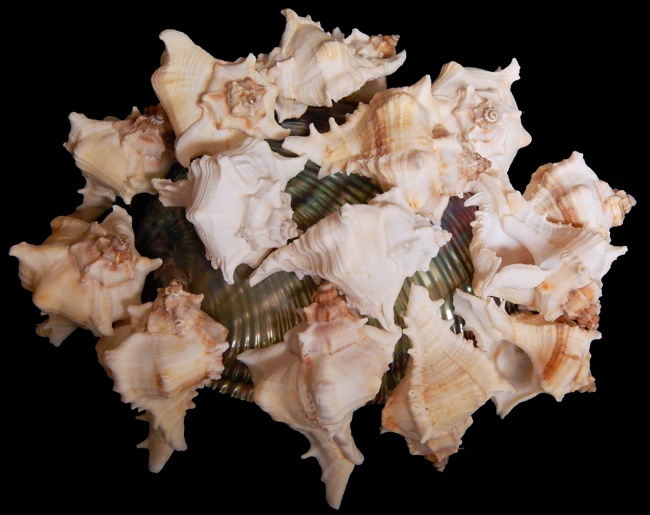
Virqenues Murex Shell
A1-10
One Virgineus Murex Shell, measuring 2 to 3.5 inches. ...... .17
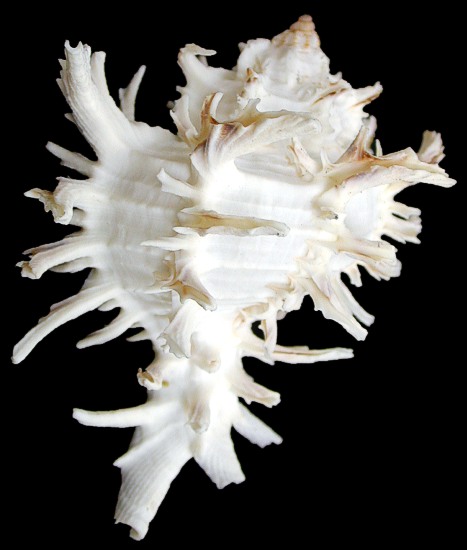
Indivia Albino (Long Spine) Murex Shell
I4-17
One Indivia Albino (Long Spine) Murex shell measuring 3 to 4 inches ...... OUT OF STOCK
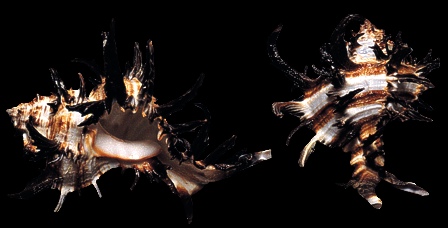
Murex Indivia Long Spine
I1-17
One Indivia (Long Spine) Murex shell, measuring 3 to 4 inches. ...... .40
I2-17
One Indivia (Long Spine) Murex shell, measuring at least 4 inches. ...… .84
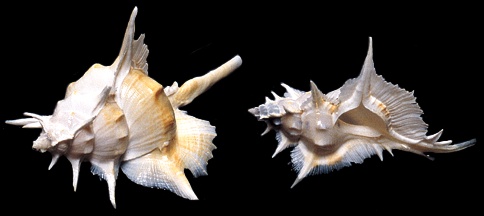
MUREX ALABASTERS SHELLS
The Murex Alabaster, known for its distinctive spines and frills, is showcased in the listing image. This shell species is native to the Indo-Pacific region, spanning from the Indian Ocean to the northern coasts of Australia.
H1-17
A Murex Alabaster shell, measuring 4 to 5 inches.....$17
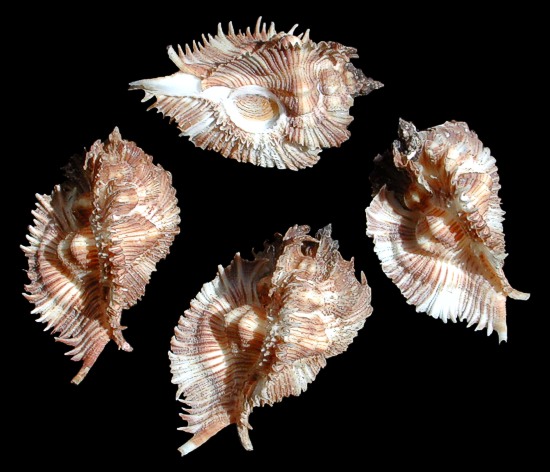
MUREX MIYOKOAE
Timbellus miyokoae, commonly known as the Miyoko Murex, is a species of sea snail, a marine gastropod mollusk belonging to the family Muricidae, which includes murex and rock snails. This species is located in the Philippines. The Miyoko Murex is uncommon and is regarded as a collector's shell.
MM-67
One Murex Miyokoae shell, measuring at least 1 1/2 inches .. .......$42
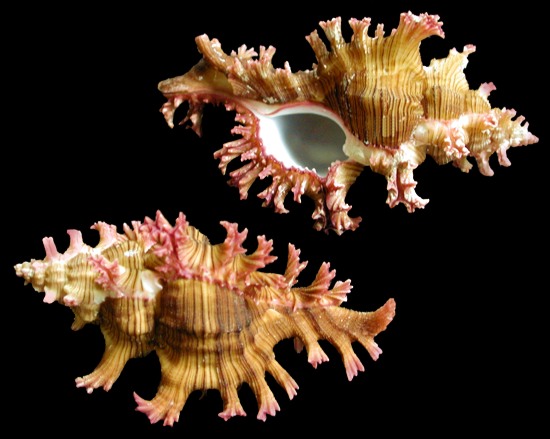
Murex Saulii
Chicoreus saulii, a species of sea snail within the Muricidae family, is a marine gastropod mollusk. It inhabits the Indian Ocean, especially in the Mascarene Basin, and extends to the Pacific Ocean, along the coasts of Japan and Papua New Guinea. Due to their rarity, these snails are frequently sought after by collectors.
Murex shells are known for their vibrant colors and diverse frills. The Murex Saulii is particularly sought after for its vivid hues and elaborate frills. Murex shells are generally heavy, though some can be light and delicate. The specimen mentioned is native to the Indo-Pacific region. Typically, murex shells are found in tropical seas, often near reefs, where they feed on invertebrates.
SMU1-251
One Murex Saulii shell measuring 2 to 2.5 inches ......OUT OF STOCK